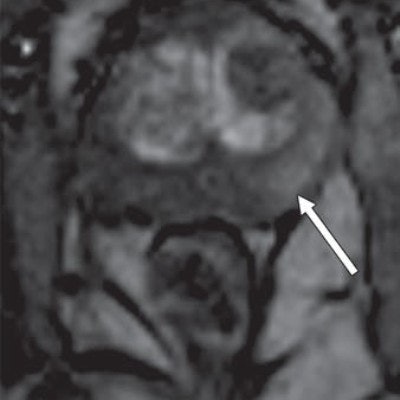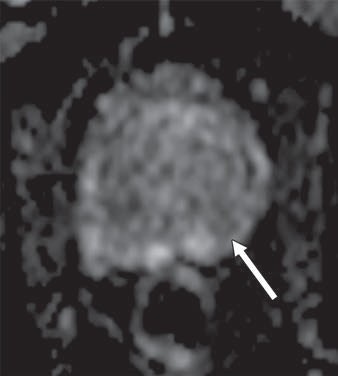
MRI can be used in place of serial biopsy as part of an active surveillance program for prostate cancer, complementing prostate-specific antigen (PSA) levels and digital rectal exams in early-stage patients. The combination could help guide who needs treatment without the need for biopsy, according to a study in the March issue of the American Journal of Roentgenology.
An active surveillance program that included multiparametric MRI revealed changes that suggested cancer progression in 12% of the subjects, according to researchers at Winthrop University Hospital in Mineola, NY. This means that the rest of the patients were spared more aggressive monitoring, such as with serial biopsy.
"The small number of patients with follow-up multiparametric MRI findings showing worsening disease supports the role of MRI in patients with early-stage prostate cancer," wrote lead author David Habibian and colleagues. "Multiparametric MRI is useful in monitoring patients on active surveillance and may identify patients with clinically significant cancer amenable to definitive treatment."
Active surveillance
For several decades, clinicians have relied on prostate-specific antigen levels as an indication of possible prostate cancer. While the test has increased detection of the disease, some studies have questioned the efficacy of PSA values, since elevated levels could be due to benign prostatic hyperplasia, inflammation, infection, or indolent disease that might never pose a risk to the individual in his lifetime.
 Initial multiparametric MRI (above) before active surveillance shows poorly defined mild hypointense signal at right posterolateral midperipheral zone (arrow). Follow-up multiparametric MRI two years later (below) better details area of hypointense signal (arrow). Images courtesy of AJR.
Initial multiparametric MRI (above) before active surveillance shows poorly defined mild hypointense signal at right posterolateral midperipheral zone (arrow). Follow-up multiparametric MRI two years later (below) better details area of hypointense signal (arrow). Images courtesy of AJR.As an alternative, clinicians have begun turning to active surveillance, which includes regular monitoring of PSA levels, digital rectal exams, and serial biopsies. But biopsies are still an invasive procedure, leading researchers at Winthrop to see if replacing serial biopsy with annual multiparametric MRI scans in their active surveillance regimen would make it more effective (AJR, March 2017, Vol. 208:3, pp. 564-569).
For this study, the group scoured the department of urology's database on prostate cancer patients who were monitored with active surveillance between February 2002 and July 2015. During that time, 200 prostate cancer patients were on active surveillance, with 114 patients (57%) having undergone an initial multiparametric MRI exam before active surveillance and at least one follow-up multiparametric MRI scan after active surveillance.
All prostate MRI scans at the hospital were performed on a 3-tesla scanner (Intera Achieva, Philips Healthcare) with a six-channel coil. The protocol included axial, coronal, and sagittal T2-weighted fast spin-echo and axial T1-weighted spin-echo sequences, as well as diffusion-weighted imaging (DWI) in the axial plane. The subjects' MR images were evaluated and correlated with pathology results, if available.
The median age of the subjects was 65 years (range, 60-70 years), with a median time on active surveillance of 48 months (range, 38-68 months). The median time on active surveillance before receiving definitive treatment was 35 months (range, 20-53 months).
Poor outcomes
In reviewing the records, the researchers found 14 patients (12%) whose active surveillance was halted when follow-up multiparametric MR images suggested prostate cancer progression. Of those 14 subjects, nine (64%) had confirmed or suspected spread of cancer beyond the prostate, three (21%) had enlarged or more prominent lesions, and two (14%) had new or suspicious lesions.
In addition, biopsy results led to a tumor upgrade and further treatment for six patients (43%) after their follow-up multiparametric MRI scans.
Due to their worsening condition, 10 patients underwent cryoablation to treat their prostate cancer, while two received radiation therapy (CyberKnife, Accuray) and two underwent radical retropubic prostatectomy.
The researchers concluded that the relatively small number of patients who had serious disease meant that MRI was a good alternative to biopsy in an active surveillance program.
"The results of our study show the potential application of multiparametric MRI in prostate cancer patients being monitored with active surveillance," Habibian and colleagues wrote. "Multiparametric MRI may serve as a substitute for serial biopsies currently used in active surveillance regimens to reduce the rate of sepsis and infection and avoid patient discomfort associated with repeat biopsies."
The researchers also recommended additional prospective studies with a larger patient sample to validate the results and the efficacy of multiparametric MRI in the management of prostate cancer patients.



















